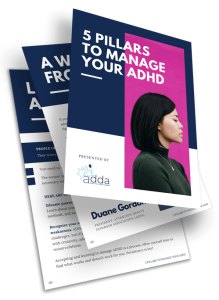
How to Break Bad Habits: A Realistic Guide for ADHDers
We all have bad habits we want to change. Maybe you find yourself endlessly scrolling social media, munching mindlessly when stressed, or constantly pushing tasks to the last possible minute.
For adults with ADHD, these aren’t just occasional slip-ups—they’re stubborn patterns that can feel impossible to break.
Here’s the good news: You can change these patterns.
The challenge? Bad habits run on autopilot. They happen automatically, almost without thought. Breaking them, especially with adult ADHD, feels tough.
But the truth is that you have more power to break these cycles than you realize.
This guide isn’t about perfect solutions or superhuman willpower. It’s about understanding the science behind your habits—what triggers them, why they persist, and how to strategically disrupt them, especially when working with an ADHD brain.
Ready to transform those automatic behaviors that have been holding you back?
Let’s dive into what actually works.
Why Breaking Bad Habits Is So Hard
Learning how to stop bad habits isn’t tough because you’re lazy or unmotivated. It’s tough because your brain is doing exactly what it was designed to do: automate repeated behaviors to save energy.
For the ADHD brain, this automation is even more powerful. Understanding what’s happening beneath the surface is the first step to creating strategies that actually work.
The Habit Loop: Cue, Routine, Reward
Every habit, good or bad, follows a loop in the order below:[1]
- Cue: A trigger can be anything, from an emotional state to a location or time of the day.
- Routine: This refers to the behavior that occurs in response to a cue.
- Reward: The reward is the payoff your brain receives after completing the behavior, reinforcing it.
Let’s say you’re feeling anxious about an upcoming deadline (cue). Almost without thinking, you grab your phone and dive into TikTok or Instagram (routine). Your brain gets a hit of dopamine, that feel-good neurotransmitter that ADHD brains especially crave, as you temporarily escape the stress (reward).
Once this pattern is repeated enough, it becomes automatic. Research shows that habits account for nearly 45% of our daily actions[2], which means most of our behavior happens without conscious thought.
Plus, the ADHD brain is especially drawn to immediate gratification, making the pull of many bad habits even stronger.

Willpower Isn’t Enough
Have you ever told yourself, “Starting tomorrow, I’ll just try harder”? It likely didn’t work out well.
Willpower is like a muscle that fatigues. For the ADHD brain, that muscle often starts with less endurance. When you’re stressed, tired, or emotionally drained (which happens frequently with ADHD), your depleted prefrontal cortex—the brain’s decision-making center—surrenders control to your basal ganglia, where those automatic habits live.
The result is that you default to whatever behavior requires the least mental energy, usually your bad habit.
Why Bad Habits Feel Comforting
Bad habits often persist because they serve a purpose or fulfill a need. They serve as coping mechanisms, temporarily alleviating stress, boredom, anxiety, or discomfort.
That late-night snacking provides comfort when you feel overwhelmed. The procrastination temporarily relieves the anxiety of facing a challenging task. The impulse shopping gives your understimulated ADHD brain a quick dopamine boost.
These behaviors exist for a reason. They work—at least in the short term. That’s why simply trying to eliminate them creates an emotional void that begs to be filled.
The key isn’t just stopping the behavior; it’s understanding what needs it fulfills and finding a healthier way to meet them.
How to Break Bad Habits (Step-by-Step)
By approaching your habits with curiosity rather than self-judgment, you will find it easier to understand their causes and find ways to break them for good.
This won’t happen overnight, but it is possible with the right approach and techniques.
Here’s how to get rid of bad habits for good.
Step 1: Identify the Habit and Its Triggers
Research shows that habits are very context-dependent. Thus, one of the most effective ways to break bad habits is to minimize exposure to habit cues and triggers.[3]
What you can do is pay attention to what prompts the behavior. Is it a certain time of day, a specific place, or an emotional state like boredom, stress, or frustration?
This self-awareness gives you a clearer picture of what sets the habit in motion.
Once you’ve identified those triggers, look for practical ways to reduce or avoid them. For example, if you tend to snack a lot while watching TV, consider changing your evening routine or keeping healthier snack alternatives within reach.

Step 2: Understand the Reward
Bad habits often persist because they offer appealing rewards, such as a quick distraction, a sense of relief, or a brief boost in mood.
Take some time to reflect on what the habit is fulfilling. Once you understand the underlying reward, finding healthier ways to meet that need becomes easier without falling back into old patterns.
For instance, if you scroll endlessly on your phone when bored or restless, the reward might be mental stimulation. In that case, you could replace the habit with a quick puzzle game or spend a few minutes journaling to engage your mind more intentionally.
Step 3: Change the Environment
Our environment plays a significant role in shaping and reinforcing our habits.
One of the most effective strategies for breaking a bad habit is to modify your surroundings to reduce temptation and make the behavior more difficult.
Start by identifying and limiting common triggers. For example, say your phone notifications often cause you to pick up your device and start scrolling through social media. If so, consider turning off notifications or placing your phone in another room during focused work periods.
Next, add friction to the bad habit itself. If social media is a recurring distraction, consider using an app blocker or logging out of your accounts.
Reducing cues and convenience in your environment makes it much easier to disrupt the habit loop.
Step 4: Replace it with a New Habit
Nature abhors a vacuum, and your brain is no different. Simply trying to stop a bad habit creates an empty space your brain will desperately try to fill, usually by reverting to the old behavior.
This is especially true for ADHD brains, which are particularly sensitive to understimulation and reward deficits.
Let’s say you binge eat whenever you’re stressed. In this case, you can look for healthier alternatives to manage your stress. For example, journaling, taking a walk, or practicing deep breathing instead.
The key is ensuring your replacement habit delivers a similar reward but with better long-term outcomes. For the ADHD brain, the replacement should be just as stimulating and accessible as the original habit, or it won’t stick.

Step 5: Make an If/Then Plan
Even with the best intentions, temptations and setbacks are bound to happen. Planning ahead with the “if/then” strategy is helpful. This gives your brain a script to follow when faced with a trigger or challenging moment.
For example, if you procrastinate when a difficult task comes up, your strategy might be: If I feel like avoiding it, I’ll commit to working on it for five minutes first. Or, if I feel the urge to check social media while working, then I will set a timer for 25 minutes of focus, followed by a 5-minute break for scrolling.
Getting started is often the hardest part, and this small action can help you overcome the initial resistance.
Consider the habits you struggle with most often, and create clear and specific ‘if-then’ plans to guide your responses.
Step 6: Track Progress and Celebrate Wins
Tracking your progress is a great way to see how far you’ve come, which can keep you motivated.
You can use a habit tracker app, a journal, or even something as simple as placing checkmarks on a calendar to mark your progress.
Here are a few helpful things you might consider tracking:
- How often you replace the bad habit with a healthier alternative
- How frequently the urge to engage in the habit arises
- How many days you’ve gone without engaging in the bad habit
Remember to celebrate small wins along the way. A small, meaningful reward—whether it’s a meal out, a treat, or a hot bath—can go a long way in keeping you motivated.
Step 7: Build Accountability
Accountability can be a powerful tool to support habit change by providing external motivation and structure.
List the habits you want to break and the positive habits you’d like to build in their place. Then, choose one or two goals to focus on and share them with someone you trust. This could be a friend, family member, coach, or therapist.
Ask them to check in with you regularly and commit yourself to being honest with them about your progress.
Having someone else involved means you don’t have to rely solely on willpower. Knowing that someone else is rooting for your success is also motivating.

How Long Does it Take to Break a Habit?
The time it takes to break a bad habit can vary significantly from person to person. Recent research suggests that, on average, it may take 1 to 65 days to break a habit, depending on the behavior and context.[4]
Factors such as the type of habit and your surroundings will all influence your progress. Some habits may shift within a few weeks. Others, especially those tied to strong emotional or environmental triggers, can take several months to break.
Ultimately, lasting change isn’t about quick fixes. While the process might feel slow, every small but intentional step can disrupt the habit loop and bring about sustainable improvements.
How to Bounce Back After a Slip-Up
Slipped up? This isn’t a failure—it’s valuable information. Every “mistake” is just another piece of the puzzle in understanding how your unique brain works.
Rather than seeing a setback as a failure, view it as a valuable learning opportunity. Reflect on what caused the slip by asking yourself questions like:
- What triggered this behavior?
- Was I feeling a specific emotion or under pressure?
- Did something in my environment or routine shift?
- What could I do differently next time?
Understanding what happened can help you refine your strategy moving forward.
Practice Self-Compassion
Breaking bad habits is no easy task. Being overly harsh or critical of yourself can drain your motivation and make it harder to stay committed.
Instead, aim to practice self-compassion. Speak to yourself with the same kindness and encouragement you’d offer a struggling close friend.
Pay attention to your inner dialogue, especially during setbacks or challenging moments. It helps to remind yourself that mistakes are a natural part of being human and an essential part of learning.

Breaking Bad Habits Can Be Life-Changing
Breaking bad habits can be tough, especially if you have ADHD. These transitions can feel overwhelming when patterns are deeply ingrained.
But you don’t need to overhaul everything at once. Start with one habit at a time, and focus on small, consistent improvements. Over time, these gentle shifts can gradually redirect your life’s path.
If you want to learn practical tips for improving your day-to-day with ADHD, check out ADDA+. You’ll get access to expert-crafted resources, courses, and webinars. You can also connect with a community of adult ADHDers to exchange support and tips on leading a successful and happy life with ADHD.
References
[1] Zhu, Y., Long, Y., Wei, L., Zhang, Y., Ma, Z., Lee, K. P., Zhang, L., & Wang, S. J. (2024). Developing cue-behavior association for habit formation: A qualitative study to explore the role of avatar in hypertension. Digital health, 10, 20552076241265217. https://doi.org/10.1177/20552076241265217
[2] McCloskey, K., & Johnson, B. T. (2021). You are what you repeatedly do: Links between personality and habit. Personality and Individual Differences, 181, 111000. https://doi.org/10.1016/j.paid.2021.111000
[3] Buabang, E. K., Donegan, K. R., Parnian Rafei, & Gillan, C. M. (2024). Leveraging cognitive neuroscience for making and breaking real-world habits. Trends in Cognitive Sciences, 0(0). https://doi.org/10.1016/j.tics.2024.10.006
[4] Edgren, R., Baretta, D., & Inauen, J. (2025). The temporal trajectories of habit decay in daily life: An intensive longitudinal study on four health-risk behaviors. Applied psychology. Health and well-being, 17(1), e12612. https://doi.org/10.1111/aphw.12612






1 Comment
This was really good. I like that it gave steps and the whole dopamine thing really hit home with me. Thanks